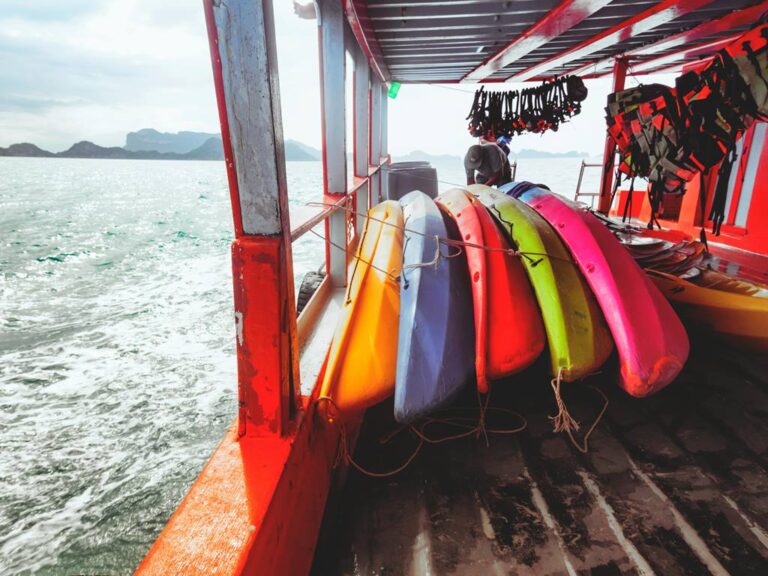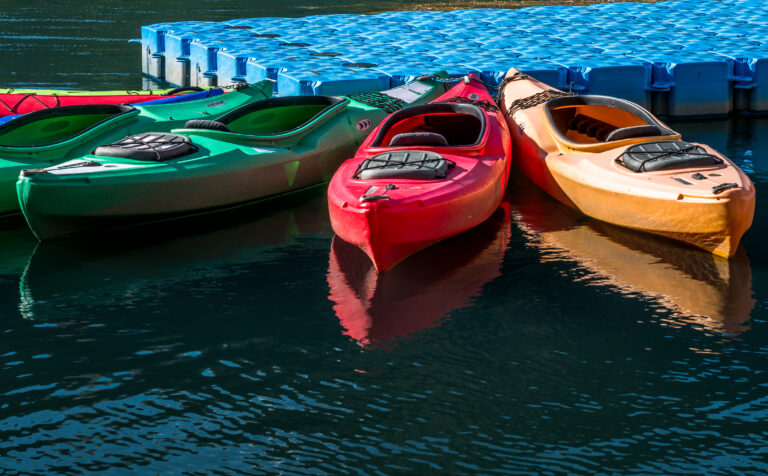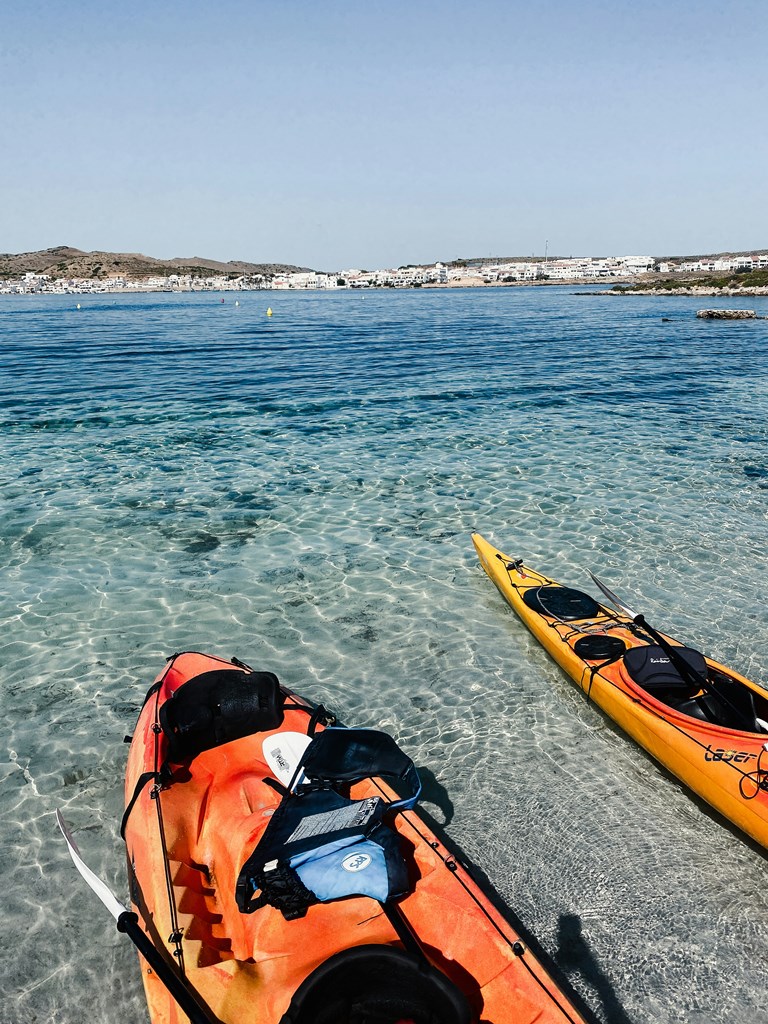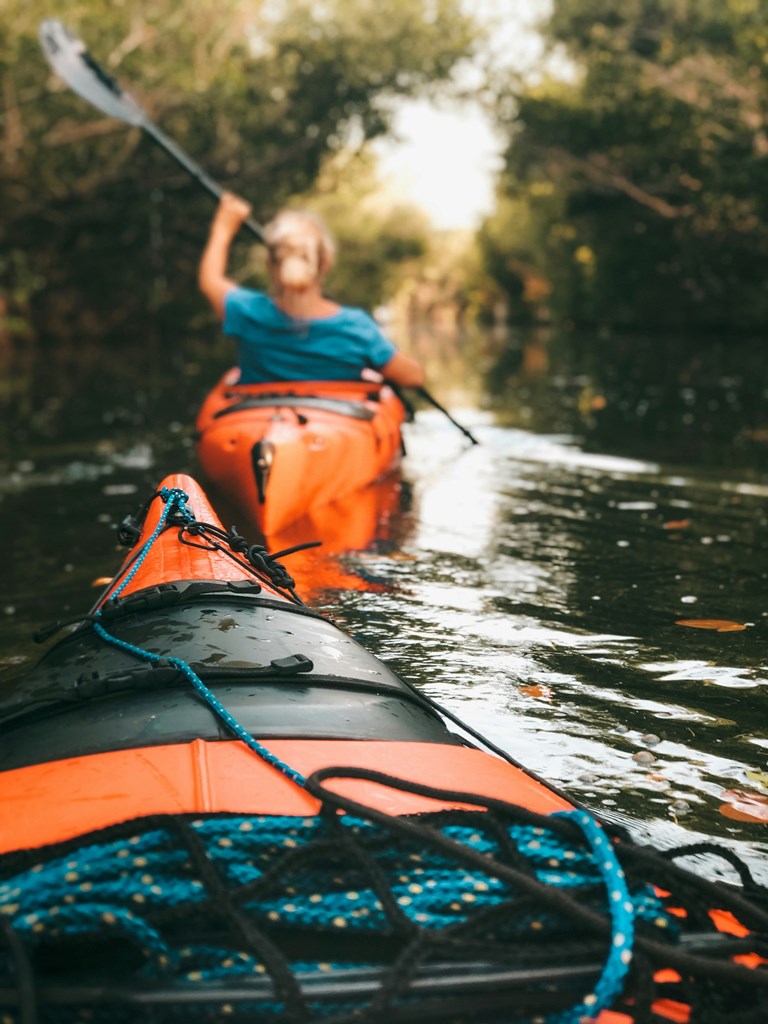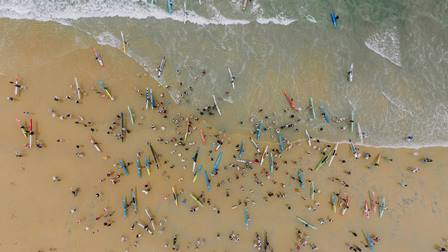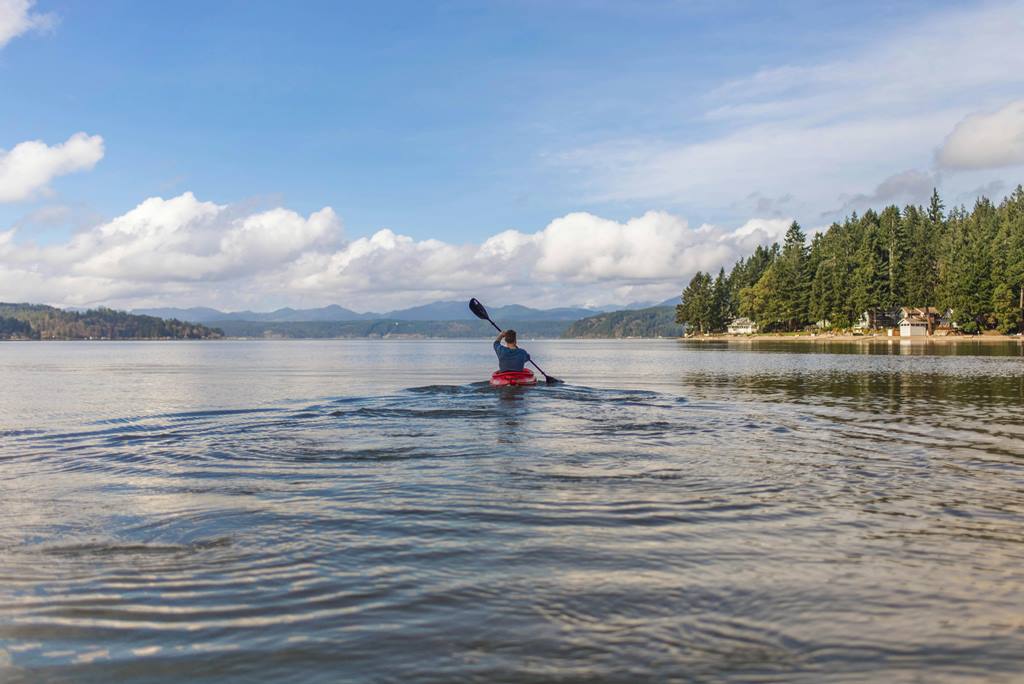
While kayaking may appear to be a simple activity – grab a paddle, hop in, and start paddling – there are many common kayak mistakes, or paddling blunders, that beginners make without even realizing it. These mistakes can range from improper use of kayak equipment to kayak safety slip-ups.
However, kayaking is a fantastic outdoor recreational activity. Imagine yourself paddling across a calm lake or river on a sunny day. This serene experience can be a great way to de-stress and forget about every day worries.
So, don’t be discouraged by the possibility of making mistakes! Most kayaking mistakes are easily avoidable or correctable. Let’s explore the top 10 common kayaking mistakes for beginners and how to fix them.
Table of Contents
1. Skipping PFD
Don’t let the term PFD (Personal Flotation Device) confuse you – it’s simply another name for a life jacket. This is a crucial piece of safety equipment that I can’t stress enough. Many kayaking mistakes can be deadly, and not wearing a PFD is a major one.
PFDs are essential for any outdoor water activity, not just kayaking. This includes canoeing, dragon boating, rowing, and more. Accidents happen unexpectedly, like a sudden capsize, and a PFD can be the difference between staying afloat and drowning. Think of it like wearing a seatbelt in your car – a no-brainer for safety, even if regulations aren’t as strict.
Even strong swimmers should wear a PFD while kayaking. In a stressful situation like a capsized kayak, you might not have your goggles, and open water is a different environment than a pool. A PFD can significantly improve your ability to stay afloat in case of an emergency. Statistics back this up – according to the 2018 US Coast Guard Recreational Boating Statistics, 77% of boating deaths were drownings, and 80% of those victims weren’t wearing a life jacket.
How to Rectify It
Make sure to put on your PFD before you even enter your kayak. It’s not a good idea to wait until you’re already on the water. Here are two key things to remember when choosing and wearing your PFD:
Proper Fit: A well-fitting PFD is crucial. A PFD that’s too large can ride up or slip off during a capsize, while a too-small one won’t provide enough buoyancy. Ensure the PFD fits snugly but comfortably around your chest and doesn’t restrict your movement.
Whistle Attachment: Attach a whistle to your PFD, but not around your neck! Hanging it around your neck could cause you to lose it if you capsize. Attaching it directly to the PFD ensures you’ll still have it readily available to signal for help in an emergency.
2. Paddling Too Far
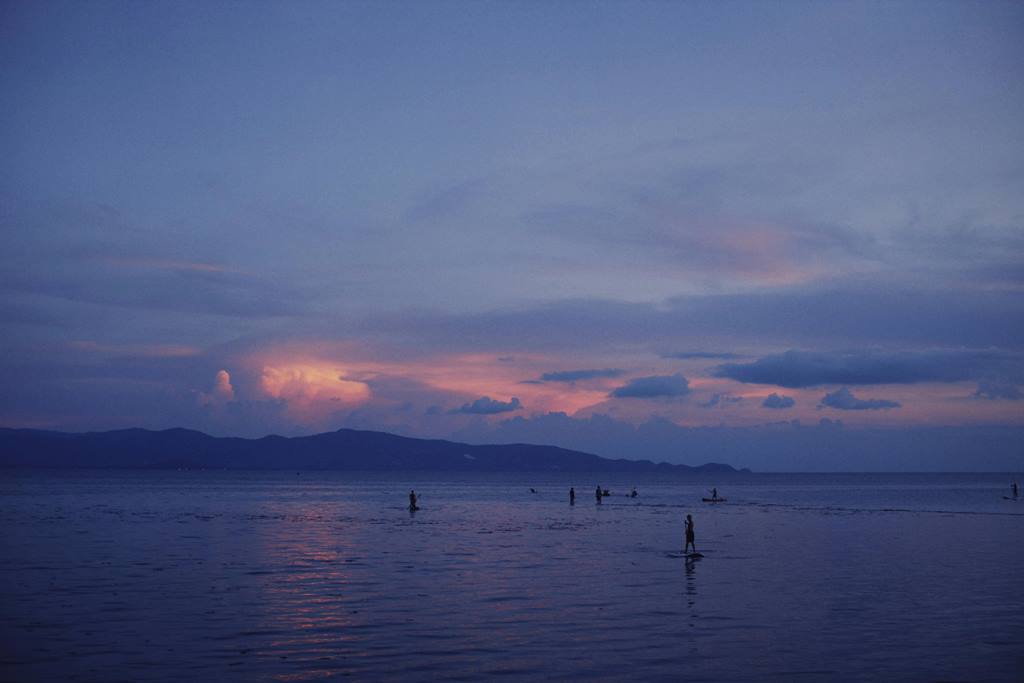
This is a critical point for beginners to remember: avoid venturing too far from shore. The excitement of paddling and exploring a new environment is understandable, but prioritizing safety is paramount.
So, what’s considered “too far”? A good rule of thumb is to stay within sight of the shore or dock. This ensures help is readily available if you encounter an unexpected situation. If you can’t be seen from shore, and someone on shore can’t see you either, you’re in a potentially risky position.
Imagine needing assistance – you wouldn’t be able to signal for help, and nobody would be able to spot you. While encountering other kayakers might be helpful, it’s not something you can always rely on. Stay within sight of the shore for a safe and enjoyable kayaking experience.
How to Rectify It
For beginners, it’s crucial to resist the urge to become a lone explorer. Stick close to shore and avoid paddling out of sight of the dock or land. This way, if you encounter any issues, help is readily available.
Focus on building your kayaking skills and confidence first. Once you feel comfortable paddling and navigating your kayak in calmer waters, you can gradually venture further afield. Remember, safety always comes first!
3. Incorrect Kayak Entry/Exit
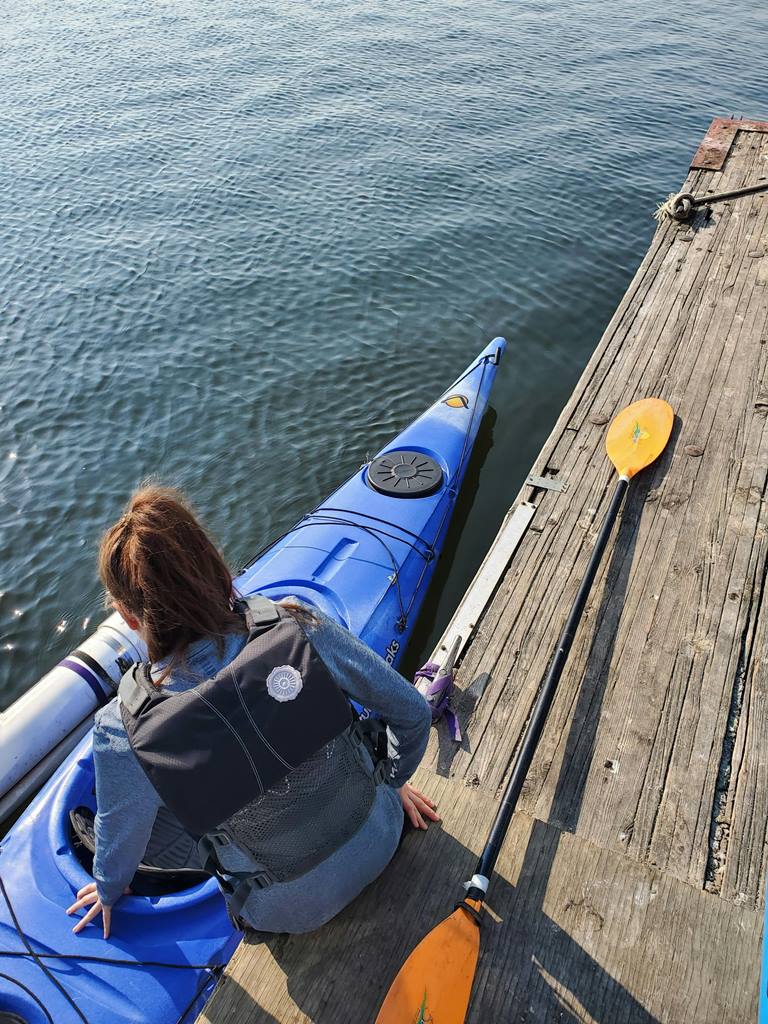
Getting in and out of a kayak might seem as easy as stepping into your car, but there’s more to it than meets the eye. Balance and safety are key!
Think about it: when you climb into a kayak, it’s natural to lose your balance for a moment as the kayak adjusts. This can lead to a fall and potential injury, especially if you hit your head.
How to Rectify It
Mastering proper entry and exit techniques is essential for safe kayaking. Here’s how to do it from the shore:
- Paddle as Outrigger: Place your paddle parallel to the shore behind the kayak seat. This paddle acts as a temporary outrigger, providing stability as you enter.
- Stable Entry: Enter the kayak from the side closest to the paddle. Use one hand to grip the paddle shaft and press down for stability as you lower yourself into the seat.
- Ready to Go: Once seated comfortably, grab your paddle and prepare to launch. You might need to use your hands to push the kayak off the shore slightly before paddling away.
- Reverse the Steps: Exiting the kayak is the same process in reverse.
Entering and exiting from a dock follows similar principles, but with a twist:
- Extra Caution: Docks can be wobbly, so be extra careful when entering or exiting.
- Helping Hand: If possible, have someone hold the kayak steady for added security.
Remember, these are general guidelines. The specific technique might vary depending on your kayak type and the environment
4. Inappropriate Dress
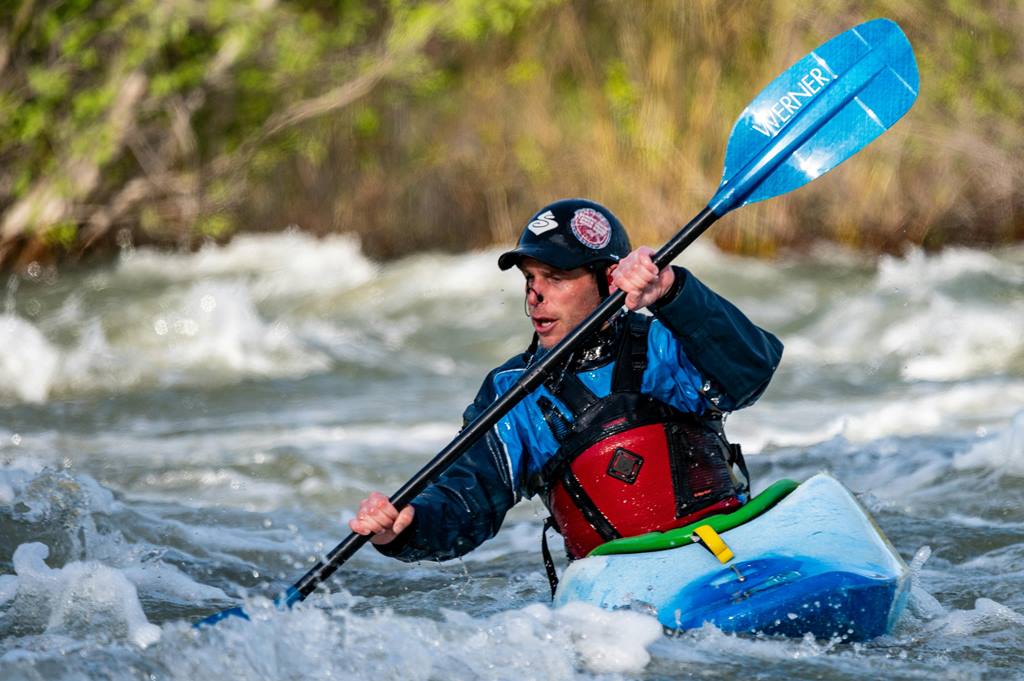
Beginner kayakers often make the mistake of dressing for the weather instead of the water. While sunny days are ideal, it’s important to choose clothing that protects you from the elements and keeps you comfortable.
Cotton T-shirts and shorts might seem like a cool choice, but they’re actually a poor option. Here’s why:
- Sun Protection: Cotton offers minimal sun protection, leaving you vulnerable to sunburn and potential skin cancer risks. Don’t forget sunscreen, but also consider sun-protective clothing with long sleeves and legs.
- Staying Dry: Cotton absorbs water readily and dries slowly. This can make you feel cold and uncomfortable, especially if you get splashed or fall in. Opt for quick-drying synthetic materials like nylon or polyester that wick moisture away from your skin.
How to Rectify It
Remember, ‘dress for the water, not the weather!’ While a sunny day might tempt you towards cotton clothes, synthetic fabrics are a much better choice for kayaking.
Consider these options:
- Synthetic Clothing: Quick-drying synthetics like nylon or polyester wick moisture away from your skin, keeping you comfortable and preventing chills.
- Wetsuit or Drysuit: For colder water or extended kayaking trips, a wetsuit or drysuit provides excellent thermal protection. A wetsuit traps a thin layer of water next to your skin for warmth, while a dry suit keeps you completely dry.
Sure, these options might not be as comfy as a cotton t-shirt, but the benefits are significant:
- Hypothermia Prevention: In case of a capsize, staying warm is crucial. Wetsuits and drysuits help prevent hypothermia, a dangerous condition caused by rapid loss of body heat.
- Sun Protection: Many synthetic fabrics offer built-in sun protection, reducing the risk of sunburn and uncomfortable tan lines.
By dressing appropriately, you can ensure a safe and enjoyable kayaking adventure!
5. Paddling Non-Straight
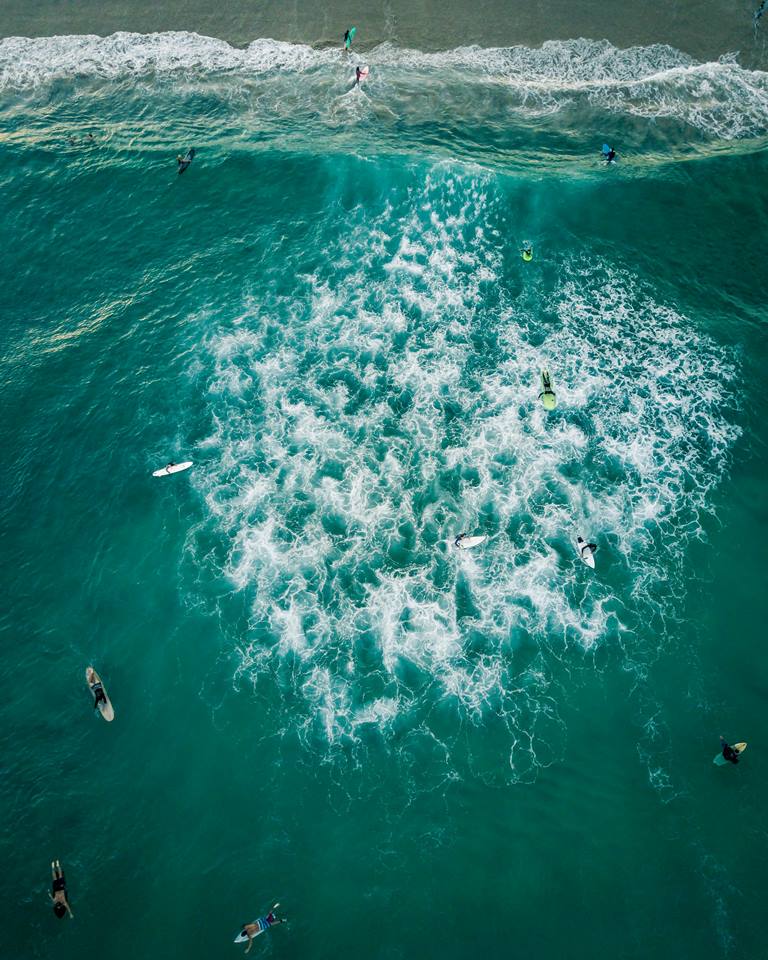
One of the most common struggles for beginners is achieving a smooth, straight path while paddling. You might find yourself mimicking professional kayakers, but end up paddling in a zig-zag pattern or with the kayak tilted to one side. This can be frustrating!
The culprit? an unbalanced paddling stroke. Here are a few reasons why this might happen:
Improper Stroke Technique: The angle of your paddle entry and exit needs to be symmetrical. Uneven strokes can result in a combination of forward propulsion and turning (sweep stroke), causing the kayak to veer off course. We’ll discuss proper paddling techniques in more detail later!
Unequal Strength: It’s natural to have a dominant hand. However, if you’re not consciously controlling your stroke strength, your dominant side might overpower the other, leading to a tilted kayak.
Weight Distribution: Poor posture or uneven weight distribution in the kayak can also cause tilting. Ensure you’re seated comfortably and centered in the kayak for optimal balance.
How to Rectify It
While mastering the perfect paddling technique takes time, here are some initial tips to help you paddle straighter and more efficiently:
- Focus on Your Stroke: Keep your paddle strokes close to the kayak, avoiding a wide sweeping motion. Imagine drawing the paddle straight back, not outwards in an arc. Remember, wide arcs are sweep strokes used for turning, not forward paddling.
- Balance Your Strokes: Be mindful of your stroke strength. Try to control your dominant hand to match the power of your non-dominant hand. This will help prevent the kayak from tilting to one side. You might even consider experimenting with different paddle types, like feathered paddles, to find what works best for you.
- Center Yourself: Sit centered in the kayak, not leaning towards one side. A good test is to gently wiggle your hips. The kayak should wobble evenly if you’re positioned correctly.
By incorporating these tips, you’ll be well on your way to developing a smoother, more efficient paddling style!
6. “Locked” Paddling
Kayaking might seem like an arm workout – after all, you’re using both arms to paddle. However, beginners often fall into the trap of focusing solely on pulling the paddle as hard as possible to go faster. This can quickly lead to fatigue and sore arms.
The secret to efficient paddling, like those seemingly effortless pros, lies in a balanced approach. It’s not just about pulling the paddle – it’s about a combination of pushing and pulling.
Imagine paddling with stiff arms and a rigid body. This might work for a short burst, but it’s not sustainable. Professional kayakers utilize their entire core to generate power, not just their arms. They twist their torso with each stroke, pushing on the paddle with their upper body on the forward stroke and pulling on the return stroke. This creates a powerful, efficient movement that conserves energy.
Remember: kayaking is about smooth, controlled movements, not just raw power!
How to Rectify It
Instead of thinking about paddling as just pulling the paddle with your arms, imagine it as a combined “push” and “pull” motion. The key to achieving this lies in torso rotation.
Here’s how it works: As you initiate the stroke, rotate your torso, not just your arms. This rotation adds power to your pull with one hand while simultaneously creating a “pushing” action with the other hand on the top of the paddle shaft. Imagine your torso swinging back and forth like a pendulum with each stroke.
By engaging your core muscles in this rotational movement, you’ll harness more power from your entire body, not just your arms. This efficient technique will help you paddle further and faster with less fatigue.
7. Rushed Paddling
Watching professional kayakers effortlessly sprint across the water can be inspiring, and it’s natural to want to emulate their speed. However, beginners often fall into the trap of paddling as fast as possible, which can lead to clumsy strokes, wasted energy, and even instability.
The secret to efficient paddling isn’t raw speed, but rather mastering rhythm and tempo.
Every forward stroke has distinct phases: catch, power, release, and recovery. Each phase requires a different level of effort. A smooth, efficient paddling rhythm ensures you apply the right amount of power at the right time during each phase.
Tempo, on the other hand, refers to the consistent speed or pace you maintain throughout your strokes. Rushing disrupts both rhythm and tempo, leading to those clumsy, inefficient strokes you described.
Focus on developing a smooth, controlled paddling style with a steady pace. This will help you navigate your kayak with greater efficiency and control, eventually leading to increased speed as your technique improves!
How to Rectify It
Mastering kayaking technique takes time and practice, just like learning to walk before you run. Here’s a breakdown to get you started:
- Focus on Form: Slow down your paddling and concentrate on proper technique. Imagine each stroke as a series of smooth, controlled motions. Think of it as perfecting your walking form before attempting to sprint.
- Find Your Tempo: Pay attention to your paddling pace. A consistent tempo, like a steady beat in music, is key to efficiency. Try counting your strokes to develop a comfortable rhythm.
- Refine Your Rhythm: As you paddle, feel the varying effort required throughout each stroke. The “catch” (beginning) and “power” (pull) phases require more strength compared to the “release” (letting go of the water) and “recovery” (bringing the paddle back) phases. Practice applying the right amount of power at the right time to develop a smooth, efficient rhythm.
Remember, patience is key! These technical aspects take time to master, but focusing on them will lay the foundation for confident and efficient kayaking.
8. Wobbling Kayaking
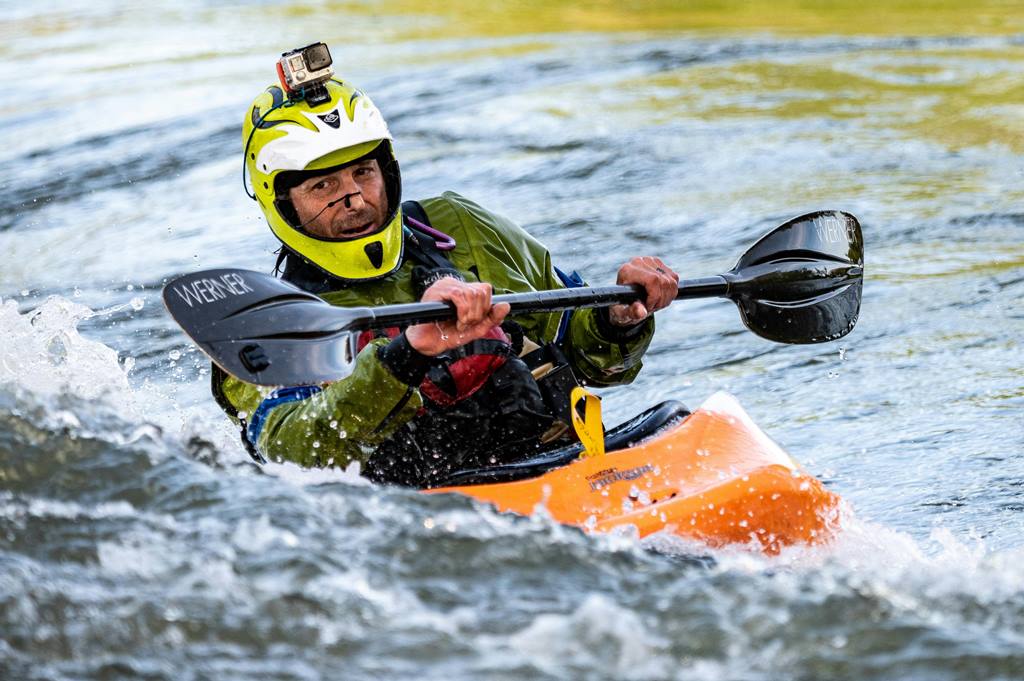
Ever feel your kayak wobbling precariously while paddling? Understanding kayak stability can help you feel more confident and in control.
There are two main types of kayak stability to consider:
- Primary Stability: This refers to how stable the kayak feels when it’s flat in the water. A wider kayak with a higher center of gravity (like a sit-on-top kayak) will typically have better primary stability, making it harder to tip over initially.
- Secondary Stability: This refers to how well the kayak resists tipping when angled or leaned to one side. Kayaks with a lower center of gravity and narrower hulls (like some sit-in kayaks) tend to have better secondary stability, allowing you to lean and manoeuvre the kayak more easily.
Why is this important? The type of kayak you choose will depend on your intended paddling activities and your comfort level. For calmer waters and beginners, a sit-on-top kayak with good primary stability might be a good option. For more experienced paddlers venturing into rougher conditions, a sit-in kayak with good secondary stability might be preferable.
How to Rectify It
Practicing edging and leaning techniques can help you improve your balance and control in the kayak. These skills are especially important for sit-in kayaks, but even recreational paddlers can benefit from understanding basic maneuvers.
For most recreational kayakers, a sit-on-top kayak offers a good balance of stability and ease of use. The wider base design provides excellent primary stability, making it less likely to tip over initially. This can be a confidence booster for beginners, especially in calmer waters. Additionally, if you do happen to capsize, getting back onto a sit-on-top is generally easier due to the lower deck height.
While sit-on-top kayaks might be a bit slower than some sit-in models, the trade-off in stability and ease of use can be ideal for recreational paddling.
9. Leaning Back
For beginners, it can be tempting to lean back and relax while paddling – it feels comfortable and allows you to enjoy the scenery. However, this posture, similar to lounging on a couch, isn’t ideal for efficient paddling.
Why? Leaning back disengages your core muscles, which are essential for generating power with each stroke. Without proper core engagement, your strokes become short and lack power, making paddling more tiring and less effective.
Here’s the key: imagine sitting tall with good posture, like you’re comfortably balanced in a chair. This allows you to engage your core and torso for more powerful and efficient strokes, making kayaking more enjoyable in the long run!
How to Rectify It
Maintaining a neutral posture is key for comfortable and efficient paddling. Here’s what that means:
- Sit Tall, Not Stiff: Imagine sitting comfortably upright, with your back relaxed but not slumped. Avoid hunching or tensing your muscles.
- Eyes Ahead: Keep your gaze forward, looking out in the direction you want to travel. This helps maintain balance and allows you to spot obstacles or changes in the water ahead.
- Core Engaged: This neutral posture naturally engages your core muscles, which are crucial for generating power with each stroke.
Remember, a comfortable and balanced posture will make kayaking more enjoyable and less tiring!
10. Neglecting Hydration Needs

Kayaking might seem like a leisurely activity, but it can provide a surprising workout! Similar to running or hiking, kayaking engages various muscle groups and can leave you feeling pleasantly tired after an outing.
Here’s why staying hydrated is crucial:
- Exertion and Sweat: Just like any exercise, kayaking causes you to exert yourself and sweat. Proper hydration helps your body function at its best.
- Regulating Temperature: Water plays a vital role in regulating your body temperature. Dehydration can lead to an increase in body temperature, which can be uncomfortable and even dangerous in hot weather.
Remember, it’s better to prevent dehydration than to treat it. Here are some tips:
- Hydrate Before, During, and After: Drink plenty of water before you even hit the water. Continue to sip water throughout your paddling session, and don’t forget to rehydrate afterwards.
- Consider Electrolytes: For longer paddling trips, consider sports drinks that can help replenish electrolytes lost through sweat.
By staying hydrated, you’ll ensure a safe and enjoyable kayaking experience!
How to Rectify It
While “just carrying 1-litre to 2-litres of water” might seem sufficient, the amount you need can vary depending on several factors.
- Duration: A shorter paddling session might require less water than a longer trip.
- Weather Conditions: Hot and sunny weather will lead to increased sweating, so you’ll need to drink more than on a cool, cloudy day.
- Activity Level: If you’re paddling intensely, you’ll need to replenish fluids more frequently than during a leisurely cruise.
Here’s a general guideline:
- Plan to bring at least 1 litre of water for every hour you’ll be paddling. Adjust this amount based on the factors mentioned above.
Remember, it’s always better to err on the side of caution and bring more water than you think you might need. You can always carry a refillable water bottle and find a place to refill it during your trip, if possible.
Conclusion
By avoiding these common pitfalls, you’ll be well on your way to mastering the art of kayaking! Remember, kayaking is a journey of learning and exploration. Embrace the process, focus on having fun, and don’t be afraid to experiment with your technique.
As you gain experience, you’ll develop a smooth, efficient paddling style that allows you to navigate the water with confidence and grace. Happy paddling!

